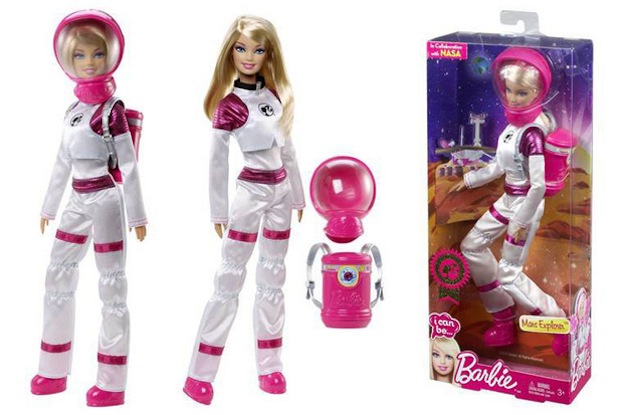Plastic Ceiling? Barbie May Limit Girls' Job Aspirations

Though Barbie boasts more than 130 careers on her resume from aerobics instructor to astronaut, the imagined job prospects for girls who play with the iconic doll may look quite different.
A small study in Oregon found that young girls who played with a Barbie saw fewer career options for themselves compared with girls who played with a Mrs. Potato Head doll.
The same held true regardless of whether the girls were playing with a Dr. Barbie or a Fashion Barbie, the researchers said. [Busted! 6 Gender Myths in the Bedroom & Beyond]
"Given the emphasis Mattel puts on the career options for Barbie, I had wondered if Dr. Barbie would boost girls' ideas about careers for themselves, but that didn't appear in these data," said study co-author Aurora Sherman, an associate professor of psychological science at Oregon State University.
Thirty-seven mostly white girls ages 4 to 7 participated in the study and were randomly assigned to play with a Fashion Barbie outfitted in a lacy dress; a Barbie dressed like a doctor with a stethoscope and a white lab coat over a tight pink glitter top; or a Mrs. Potato Head doll with accessories such as purses and shoes.
The investigators then showed the girls pictures of 11 different workplaces ranging from a classroom to a firehouse. None of the images featured people, but they were meant to represent one neutral career (restaurant server), five female-dominated jobs (teacher, librarian, daycare worker, flight attendant and nurse) and five male-dominated jobs (construction worker, firefighter, pilot, doctor and police officer).
The girls were asked, "Could you do this job when you grow up?" and then, "Could a boy do this job when he grows up?"
Sign up for the Live Science daily newsletter now
Get the world’s most fascinating discoveries delivered straight to your inbox.
The researchers found that the girls who had been playing with the Barbies thought they could do fewer jobs than boys. However, girls who played with Mrs. Potato Head saw nearly the same number of career options possible for themselves as they did for boys. [6 Myths About Girls and Science]
"This study offers important evidence that the types of toys girls are exposed to really do influence the career opportunities they see available to them, and it is especially compelling because the experimental design isolated the effects of toys like Barbie from the myriad of similar cultural images," Elizabeth Sweet, a postdoctoral researcher in sociology at the University of California, Davis, who was not involved in the study, told Live Science.
Sherman and her co-author, who published their results in the journal Sex Roles this month, speculated that the girls saw fewer career options for themselves because Barbie may serve as a "limiting model" due to her unrealistic body shape and sexualized appearance.
"One psychological theory indicates that adult women who are given cues of sexualization (through dress or pictures) perform worse on academic tasks," Sherman said in an email to Live Science. "My co-author and I speculate that Barbie might work as the same kind of cue for girls, but more research is needed to fully test this speculation."
While Sherman said she couldn't give recommendations for toy companies like Mattel to broaden girls' horizons, she did have four tips for parents:
- Take a look at the variety of options in your child's toy box. If there is a heavy emphasis on one kind of toy, like fashion dolls or action figures, consider adding some variety, such as books, games, puzzles, science kits or outdoor toys such as balls or jump ropes. If grandparents or other relatives ask for a gift list for birthday or Christmas, offer them alternatives to dolls or action figures. Try to diversify the toy box.
- When playing with your child, break, rather than reinforce, stereotypes. Build a spaceship or an airplane for a doll and encourage play that sends the toy to the moon or around the world. Explain why high-heeled shoes wouldn't be practical footwear for a veterinarian in real life. Explain that the shape and size of fashion dolls are not humanly possible and also that the child has value in the world beyond their appearance.
- Assess the child's media "diet" as well. What kind of role models are common or valued in the television shows, movies or music she or he consumes regularly? Can that be expanded to include a wider variety?
- Remember that child development is very complex and no one toy or experience is going to determine fully any outcome for children. It is worth assessing the kind of messages children's toys are sending, but to remember the complexity of the developing child.
Follow Megan Gannon on Twitter and Google+. Follow us @livescience, Facebook & Google+. Original article on Live Science.











